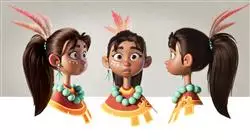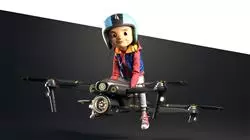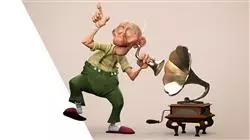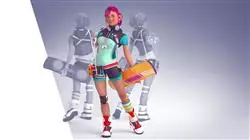University certificate
The world's largest faculty of information technology”
Why study at TECH?
If one of your dreams is to create a character for film or video games, this program is made for you"

As an audiovisual technique, the branch of computer design is capable of developing virtual characters to exist in a 3D space. It is a complex process of transforming a concept such as a character or a thing, essentially an idea, into a 3D model. This program presents styling techniques, an art that not everyone masters. For this, it will be necessary to lay the foundations of realism, so that the students will be able to transform what they have learned into a character as realistic as possible or a cartoon, which they will be able to use later on.
To understand the characteristics of clothing, its seams, folds, zippers, and how all these elements are affected by movement, Marvelous Designer will be used, a software perfect for the creation of fabrics for both Real-Time and film. With this program the student will design perfect patterns and textures with which to dress the previously created character. Furthermore, the rendering will be further developed to achieve an optical effect that allows a realistic vision, with depth and texture. To do this, it is important to play with lighting, which is an important element when it comes to recreating the model you have in mind. This program will enable the graduate to refine the composition of color, light, shapes, and elements that will enhance his or her work.
In addition, the Postgraduate diploma in 3D Character Modeling is a 100% online program. This means that the graduate can download all the teaching material from the first day, and can even choose the order in which to cover the entire syllabus. At TECH, it is the program that adapts to the work rhythms and responsibilities of the students.
You will be adept at mastering both simple and complex patterns to recreate any fabric"
This Postgraduate diploma in Postgraduate diploma contains the most complete and up-to-date educational program on the market. Its most notable features are:
- The development of practical cases presented by experts in 3D Character modeling
- The graphic, schematic, and practical contents with which they are created, provide practical information on the disciplines that are essential for professional practice
- Practical exercises where the self-assessment process can be carried out to improve learning
- Its special emphasis on innovative methodologies
- Theoretical lessons, questions to the expert, debate forums on controversial topics, and individual reflection assignments
- Content that is accessible from any fixed or portable device with an Internet connection
A good presentation speaks a lot about you as an artist, so you will refine the composition of color and light, as well as the forms and elements that enhance your work"
The program’s teaching staff includes professionals from the field who contribute their work experience to this educational program, as well as renowned specialists from leading societies and prestigious universities.
The multimedia content, developed with the latest educational technology, will provide the professional with situated and contextual learning, i.e., a simulated environment that will provide immersive education programmed to learn in real situations.
The design of this program focuses on problem-based learning, through which the professional must try to solve the different professional practice situations that arise during the academic year. For this purpose, the students will be assisted by an innovative interactive video system created by renowned and experienced experts.
You will learn how to use Marvelous Designer, the perfect software for the creation of fabrics for both Real-Time and film"

You will be able to create from the most realistic character to the most charismatic cartoon character"
Syllabus
Industry professionals have brought together in three very practical modules, stylized characters and clothing simulation, as well as rendering, lighting and model posing. This Postgraduate diploma covers everything from sculpting the head, hair and face of the Low Poly model into High Poly to exporting clothes from Marvelous Designer to Zbrush. All this bringing together the techniques of lighting, color and shadows applied to 3D modeling.

A practical syllabus with which you will recreate every detail of every character you set out to model in 3D"
Module 1. Stylized Characters
1.1. Choice of a Stylized Character and Blocking of Base Forms
1.1.1. References and Concept Arts
1.1.2. Base Forms
1.1.3. Deformities and Fantastic Shapes
1.2. Conversion of our Low Poly to High Poly model: Head, Hair and Face Sculpting
1.2.1. Head Blocking
1.2.2. New Hair Creation Techniques
1.2.3. Improvements
1.3. Model Refinement: Hands and Feet
1.3.1. Advanced Sculpting
1.3.2. Refinement of General Shapes
1.3.3. Shape Cleaning and Smoothing
1.4. Creation of Jaw and Teeth
1.4.1. Creation of Human Teeth
1.4.2. Increase its Polygons
1.4.3. Fine Detailing of Teeth in Zbrush
1.5. Modeling Clothing and Accessories
1.5.1. Types of Cartoon Clothing
1.5.2. Zmodeler
1.5.3. Applied Maya Modeling
1.6. Retopology and Clean Topology Creation from Scratch
1.6.1. Retopology
1.6.2. Loops According to the Model
1.6.3. Optimization of the Mesh
1.7. UV Mapping and Baking
1.7.1. UV’s
1.7.2. Substance Painter: Baking
1.7.3. Polishing Baking
1.8. Texturing and Painting In Substance Painter
1.8.1. Substance Painter: Texturing
1.8.2. Handpainted Cartoon Techniques
1.8.3. Fill Layers with Generators and Masks
1.9. Lighting and Rendering
1.9.1. Lighting of Our Character
1.9.2. Color Theory and Presentation
1.9.3. Substance Painter: Render
1.10. Posing and Final Presentation
1.10.1. Diorama
1.10.2. Posing Techniques
1.10.3. Presentation of Models
Module 2. Rendering, Lighting and Posing of Models
2.1. Characters Posing in ZBrush
2.1.1. Rig in zbrush with ZSpheres
2.1.2. Transpose Master
2.1.3. Professional Finish
2.2. Rigging and Weighting of our Own Skeleton in Maya
2.2.1. Rig in Maya
2.2.2. Rigging Tools with Advanced Skeleton
2.2.3. Rig Weighting
2.3. Blend Shapes to Give Life to Your Character's Face
2.3.1. Facial Expressions
2.3.2. Blend Shapes of Maya
2.3.3. Animation with Maya
2.4. Mixamo, a Quick Way to Present Our Model
2.4.1. Mixamo
2.4.2. Mixamo Rigs
2.4.3. Animations
2.5. Lighting Concepts
2.5.1. Lighting Techniques
2.5.2. Light and Color
2.5.3. Shade
2.6. Arnold Render Lights and Parameters
2.6.1. Lights with Arnold and Maya
2.6.2. Lighting Control and Parameters
2.6.3. Arnold Parameters and Configuration
2.7. Lighting of our Models in Maya with Arnold Render
2.7.1. Lighting Set Up
2.7.2. Model Lighting
2.7.3. Mixing Light and Color
2.8. Going Deeper in Arnold: Denoising and the Different AOV's
2.8.1. AOVs
2.8.2. Advanced Noise Treatment
2.8.3. Denoiser
2.9. Real-Time Rendering in Marmoset Toolbag
2.9.1. Real-Time vs. Ray Tracing
2.9.2. Advanced Marmoset Toolbag
2.9.3. Professional Presentation
2.10. Post-Production Rendering in Photoshop
2.10.1. Image Processing
2.10.2. Photoshop: Levels and Contrasts
2.10.3. Layers: Characteristics and their Effects
Module 3. Clothing Simulation
3.1. Importing your Model to Marvelous Designer and Program Interface
3.1.1. Marvelous Designer
3.1.2. Software Functionality
3.1.3. Real-Time Simulations
3.2. Creation of Simple Patterns and Clothing Accessories
3.2.1. Creations: T-shirts, Accessories, Hats and Pockets
3.2.2. Fabric
3.2.3. Patterns, Zippers and Seams
3.3. Advanced Clothing Creation: Complex Patterns
3.3.1. Pattern Complexity
3.3.2. Physical Qualities of Fabrics
3.3.3. Complex Accessories
3.4. Clothing Simulation at Marvelous
3.4.1. Animated Models at Marvelous
3.4.2. Fabric Optimization
3.4.3. Model Preparation
3.5. Export of Clothing from Marvelous Designer to ZBrush
3.5.1. Low Poly in Maya
3.5.2. UV's in Maya
3.5.3. Zbrush, Use of Reconstruct Subdiv
3.6. Refinement of Clothing
3.6.1. Workflow
3.6.2. Details in Zbrush
3.6.3. Clothing Brushes in Zbrush
3.7. Improve the Simulation with ZBrush
3.7.1. From Tris to Quads
3.7.2. UV's Maintenance
3.7.3. Final Carving
3.8. High Detail Clothing Texturing in Mari
3.8.1. Tileable Textures and Fabric Materials
3.8.2. Baking
3.8.3. Texturing in Mari
3.9. Maya Fabric Shading
3.9.1. Shading
3.9.2. Textures Created in Mari
3.9.3. Realism with Arnold Shaders
3.10. Render
3.10.1. Clothing Rendering
3.10.2. Illumination in Clothing
3.10.3. Texture Intensity

You will master the main design tools that will distinguish you as a creative and efficient 3D specialist"
Postgraduate Diploma in 3D Character Modeling
3D character modeling is a technique used to create character models in three dimensions, which can be used in animation applications, video games, virtual reality, among others.
To create a 3D character model, 3D modeling programs are used, which allow to create a polygonal mesh of the human anatomy, and then proceed to the modeling of all surface details and their individual characteristics (clothing, hair, skin, eyes, etc.). In addition, textures, colors or patterns are attributed to it, to create a realistic and differentiated appearance.
These characters can be animated with rigging and animation tools, allowing you to create movements and facial expressions according to your needs. The application of 3D character modeling is wide, a good modeling can be used to create animations, games, online advertising, movies and TV series, among others. Through the creation of 3D characters it is possible to develop more attractive and realistic content, which can generate a greater impact on the audience. For example, in advertising 3D characters are used to sell products, in video games they are used to create characters with unique abilities and in movies to create impressive characters and special effects.
The goal of the program is to provide students with an advanced understanding of the tools and techniques needed to create realistic and detailed 3D characters. Students will learn how to design 3D characters from scratch, starting with the fundamentals of modeling and anatomy, and becoming familiar with texturing, shading, lighting and animation techniques. Emphasis will also be placed on the importance of rigging and skinning as the technique of bringing characters to life, and on the ability to produce high quality results through the use of advanced rendering and 3D post-production software. The intention of the program is to train experts in 3D character modeling capable of creating characters for audiovisual productions and video games that meet the most demanding industry standards.







